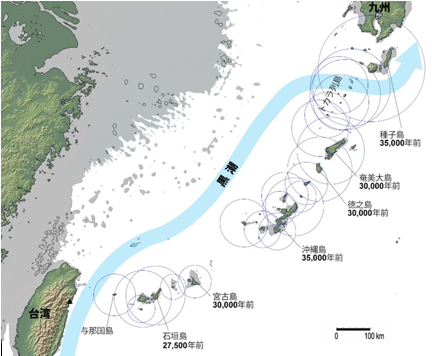2025-06-26 東京大学

図1:3万数千年前の琉球列島と各島における最古の遺跡のおおよその年代。海面を80 m 下げて陸化する部分をグレーで示してある。円は海上から島が見える範囲。黒潮の流路は推定される3万5000 年前のもの。▲は図2を撮影した立霧山。背景地図はGeoMapAppにて作成。
<関連情報>
- https://www.um.u-tokyo.ac.jp/research/umutnews/20250626.html
- https://www.science.org/doi/10.1126/sciadv.adv5507
- https://www.science.org/doi/10.1126/sciadv.adv5508
東アジアにおける旧石器時代の海上生活: ダグアウトカヌー仮説の実験的検証 Paleolithic seafaring in East Asia: An experimental test of the dugout canoe hypothesis
Yousuke Kaifu, Chih-Hsing Lin, Nobuyuki Ikeya, Masahisa Yamada, […] , and Akira Goto
Science Advances Published:25 Jun 2025
DOI:https://doi.org/10.1126/sciadv.adv5507
Abstract
Archeological evidence indicates that full-scale expansion of Homo sapiens across the oceans began about 50,000 years ago in the Western Pacific, yet how this was achieved remains unclear. The Ryukyu Islands in southwestern Japan, where archaeological sites suddenly appeared 35,000 to 30,000 years ago, are of particular interest in this regard because of the apparent difficulty in crossing the surrounding waters. In this study, we test if a non-sailing dugout canoe can be produced with Upper Paleolithic tools, and if it can cross the 110-kilometer-wide strait at the western entrance of the Ryukyus, where one of the world’s strongest ocean currents intervenes. Our 7.5-meter-long dugout, manufactured with edge-ground stone axes, was speedy and durable enough to cross this strait. This supports the early development of functional boats, such as dugouts, while our experiment also highlighted that this type of sea travel was possible only for experienced paddlers with advanced navigational skills.
黒潮の横断: 世界最強の海流のひとつを渡る旧石器時代の移動 Traversing the Kuroshio: Paleolithic migration across one of the world’s strongest ocean currents
Yu-Lin K. Chang, Yasumasa Miyazawa, Xinyu Guo, Sergey Varlamov, […] , and Yousuke Kaifu
Science Advances Published:25 Jun 2025
DOI:https://doi.org/10.1126/sciadv.adv5508
Abstract
The maritime migration to the South Ryukyu Islands of southwestern Japan, which occurred approximately 30,000 years ago, was one of the most difficult sea crossings accomplished by the Late Pleistocene Homo sapiens. This study performs numerical simulations to investigate the conditions that were needed to cross between Taiwan and Yonaguni Island, where one of the world’s strongest ocean currents, the Kuroshio, remains active. We combined simulations based on three ocean models with data from an actual experimental voyage conducted in 2019. The results showed that travel across this sea would have been possible on both the modern and Late Pleistocene oceans if a dugout canoe was used with a suitable departure place and paddling strategy. Recognizing the Kuroshio, paddling to counteract this current, and using high-level navigation were crucial to success. This suggests that the Paleolithic maritime expansion in the Western Pacific involved both advanced technologies and strategic challenges.



